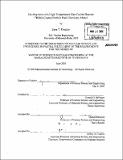Development of a High Temperature Gas-Cooled Reactor TRISO-coated particle fuel chemistry model
Author(s)
Diecker, Jane T
DownloadFull printable version (7.196Mb)
Other Contributors
Massachusetts Institute of Technology. Dept. of Nuclear Engineering.
Advisor
Ronald G. Ballinger.
Terms of use
Metadata
Show full item recordAbstract
The first portion of this work is a comprehensive analysis of the chemical environment in a High Temperature Gas-Cooled Reactor TRISO fuel particle. Fission product inventory versus burnup is calculated. Based on those results a thermodynamic analysis is performed to determine fission product vapor pressures, oxygen partial pressure, and carbon monoxide and carbon dioxide gas pressures within the fuel particle. Using the insight gained from the chemical analysis, a chemical failure model is incorporated into the MIT fuel performance code, TIMCOAT. Palladium penetration of the SiC layer is added to the fracture mechanics failure model. Rare-earth fission product and palladium corrosion of the SiC layer are additionally modeled. The amoeba effect is added as a new failure mode. The palladium penetration model has the most significant result on the overall fuel performance model and increases the number of predicted particle failures. The thinning of the SiC layer due to fission product corrosion has a slight effect on the overall fuel performance model. Finally, the amoeba effect model does not lead to any particle failures, but adds to the completeness of the overall model.
Description
Thesis (S.M.)--Massachusetts Institute of Technology, Dept. of Nuclear Engineering, 2005. Includes bibliographical references (p. 135-137).
Date issued
2005Department
Massachusetts Institute of Technology. Department of Nuclear Engineering; Massachusetts Institute of Technology. Department of Nuclear Science and EngineeringPublisher
Massachusetts Institute of Technology
Keywords
Nuclear Engineering.